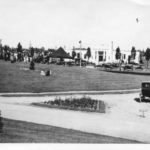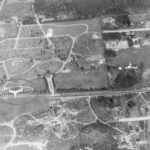Evergreen Washelli Columbarium celebrates 100 year anniversary
Sep 14, 2022, 10:29 AM | Updated: 11:26 am
A distinctive facility in North Seattle is observing its centennial this year and is inviting everyone to attend a festive party … in a cemetery.
This year marks the centennial of the Columbarium at Evergreen Washelli Cemetery – which is in the Licton Springs neighborhood along Aurora Avenue. The big party is next Wednesday, Sept. 21, at 1 p.m. There’ll be refreshments, guided tours, and even a horse-drawn hearse. And it’s all free.
Now, you may be wondering, what, exactly, is a “columbarium?”
“It is like an indoor cemetery, if you will, with glass-front niches where the urns are placed behind the glass, so you can see them,” said Evergreen Washelli location manager Nikole Mitchell. “And ours happens to be not quite the oldest in the state, but definitely the largest and very old.”
“Columbarium” originally meant “pigeon house” because “columba” is Latin for pigeon. So, at least in appearance, think of a wall of little niches for pigeons – or for urns of cremated remains – there is apparently some similarity. According to the Oxford Dictionary, the use of the term to describe a place for ashes rather than pigeons dates to 18th century Europe.
What’s now called Evergreen Washelli – which initially only had earth burials – dates to the late 19th century. It was originally known as Oak Lake Cemetery, created in 1884, when property owners David and Louisa Denny moved the remains of their infant son Jonathan there from two earlier burial places downtown. Moving the graves within entire cemeteries was a hazard to living in a young and rapidly expanding metropolis. For instance, what is now Denny Park in downtown Seattle was once a cemetery, and all those graves had to be moved elsewhere when the land became a public park.
Fast-forward from 1884 to 1920, and Seattle was still growing, of course. Competing cemeteries which would merge by 1928 and become “Evergreen Washelli” (“Washelli” was used for an earlier cemetery in Seattle and is said to be an Indigenous word) were now on both sides of what would become Highway 99. The Great War was over, cars were beginning to take over as a dominant form of transportation, and even distant neighborhoods were filling in. So, offering an alternative to earth burials – even on what was then the distant edge of the metropolis – made sense as a long-term business and space-utilization strategy.
Add to the realities of the rapidly growing population, the fact that Seattle is famously fairly liberal, and Seattleites are not so much into organized religion – both of which were already true even 100 years ago.
Scott Sheehan, general manager of Evergreen Washelli, says these factors may have also contributed to the decision to build the Columbarium in 1920.
“I think the demographics are a really interesting piece, because if you look at Washington as a whole, we look at Seattle, we’re in the top tier of the more ‘unchurched,’ if you will,” Sheehan told KIRO Newsradio. “And then you look at the cremation trend from say, the past hundred years, [and] you’ll see that there is a correlation in there, definitely.”
“Now today, I think that’s changed considerably, but there is a definite correlation to the Pacific Northwest being kind of that ‘frontier,’” Sheehan said. There were the common sentiments of, “’we’re going to go our way, [and we] don’t care what mom and dad’s church said’” when it came to choosing cremation rather than a more traditional burial.
When the Columbarium opened at Evergreen Washelli in 1922, the ornate building was decorated with columns and other ornamental details that gave it a classical and distinctive look. As Scott Sheehan and Nicole Mitchell spread out old photos of the structure on a table in the Evergreen Washelli offices on the west side of Aurora, it was easy to conclude that this original Columbarium had somehow been replaced.
But that conclusion would be incorrect. As it turns out, the exterior of that original 1922 building was “modernized” sometime around 1960. Workers stripped away all the ornamentation and made it a very non-descript box of a building. Apparently, Scott Sheehan says, this was because the vibrations from the adjacent busy lanes of Aurora/Highway 99 had damaged that ornate 1922 façade beyond repair.
Fortunately, while there have been a number of changes to the inside of the Columbarium, overall the interior feels a lot less modernized and more like a facility marking its 100th birthday. The interior is separated by walls and doorways, which create a number of discrete spaces and rooms with “niches” – the places for containers of cremated remains – of different sizes stretching from the floor to way up high next to the ceiling. With those niches, many of which are glass-fronted and organized into uniform columns and rows, it has the feel of an exclusive reference library protecting thousands of rare volumes, or the public area of an old big-city postal annex with thousands of post office boxes.
Either way, the “thousands” figure is correct. The Evergreen Washelli Columbarium, which is open daily, houses the remains of more than 35,000 people, and there’s still room for more, Scott Sheehan says.
And among those thousands already there, Mitchell says, is an interesting mix of historical figures. Stories of several will be highlighted on temporary interpretive signage throughout September, and through guided tours during the public event Sept. 21.
Walking through the interior spaces, Mitchell points out niches for early Seattle baseball broadcaster Leo Lassen; sporting goods retailer and restaurateur Ben Paris; and a Japanese American who survived incarceration at Minidoka.
And, as is often the case at a cemetery, sometimes the remains of figures with vastly different backgrounds or with radically different “success stories” have become eternal neighbors.
“Alvin Puetz, who started Puetz Golf, which is really just down the street,” Mitchell said, pointing to a niche. “His claim to fame is that before he and his brother started Puetz Golf, there was no such thing as maybe like a retail golf store – it was all at country clubs. So they found a really solid economic niche in basically making golfing accessible to the public.”
“And then behind you,” Mitchell continued, pointing over from Alvin Puetz, “is Reverend [Samuel] McKinney. His wife is there in the center and he is there, and of course, he was a huge pioneer in civil rights, marching with Dr. King – lots of historical meetings for the civil rights movement – and then he was the pastor at Mount Zion Baptist Church in Seattle for maybe 30-plus years.”
One thing that becomes clear about Evergreen Washelli, both in the Columbarium and in the earth burials, is that it is home to many, many figures from Seattle history, such as the city’s first woman mayor Bertha Knight Landes; Indigenous resident known as John Cheshiahud; civic booster and judge (and trail namesake) Thomas Burke; the Doughboy statue which graces the veterans’ section; and, of course, cemetery founders and early settlers David and Louisa Denny. For anyone who loves Seattle history, a walk through the Columbarium or a stroll through the grounds will reveal many familiar names.
However, unlike Lake View Cemetery on Capitol Hill, there are no “celebrities” whose fame might make Evergreen Washelli more of an out-of-town tourist destination.
Nikole Mitchell has mixed feelings about that.
“People come here sometimes and say, ‘oh, where’s Brandon Lee’s grave, where’s Bruce Lee?” and that does irritate me a little bit,” Mitchell concedes. “But I do think there’s a whole separate barrage of issues that come with that. I mean, I was in Paris visiting Jim Morrison’s grave, and it’s like people are actively doing drugs, playing music, drinking [and] there’s all kinds of memorabilia around that space.”
“I imagine [a cemetery] has a whole different feel to it when you are in that realm,” Mitchell said.
So far, similar activities have not been observed at the graves of Judge Burke or Mayor Landes.
IF YOU GO
Evergreen Washelli Columbarium Centennial
11220 Aurora Ave North in Seattle
Wednesday, September 21 at 1:00 p.m.
Free admission.
You can hear Feliks every Wednesday and Friday morning on Seattle’s Morning News with Dave Ross and Colleen O’Brien, read more from him here, and subscribe to The Resident Historian Podcast here. If you have a story idea or questions, please email Feliks here.






















